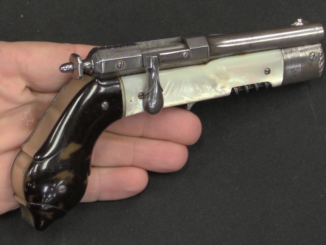Today at the Backup Gun Match, I’m shooting a French Modèle 1892 service revolver. It’s a 6-shot revolver with a swing-out cylinder, chambered for the 8x27mm cartridge (often called 8mm Lebel, although it really shouldn’t be). I’ll be shooting in a mix of single action and double action as seems best on each stage. This particular 1892 was made in 1922 and is really rough on the outside but very nice on the inside.
All things considered, it’s not a bad gun. Definitely underpowered by modern standards, but that does make it a very pleasant gun to shoot, with minimal recoil. The sights are pretty decent for 1892, but the trigger is not great. Still, I think I was able to put up a pretty respectable performance.
General Rules for the B.U.G. Match:
Score is points minus time. Time is recorded as the number of full seconds only (ie, 5.75 seconds is scored as 5). All targets are worth up to 7 points. Steel that falls is full score, and 3 points per hit that does not cause it to fall. Paper targets are worth 7 in the head, 5 in the A zone, 3 in the C zone, and 1 in the D zone. Shoot as much or as little as you like; no penalties for missing or not engaging.




Nice to see such “ancient” weapon in useable condition; shooting is pretty impressive too. I believe it is the same “Lebel” revolver as shown here https://en.wikipedia.org/wiki/Mod%C3%A8le_1892_revolver
I should mail some of my moustache wax out to Arizona… 50/50 beeswax and coconut oil with a dab of huile d’olive and some rosemary.
At least Ian had the PC/HC silly hat: kepi!
At some point I’ll have to get a Rast Gasser M1898 and give one of these action shoots a try with that!
Note that the cylinder swing out is the opposite of a modern revolver on the French ordnance revolver…
“(…)cylinder swing out is the opposite of a modern revolver(…)”
It is said to stem form French cavalry requirement, which considering saber to be more important weapon and thus revolver to be secondary and fired using non-dominant hand.
Nonetheless it was ahead of other European revolvers in combining fixed frame and quick loading.
According to http://www.waffensammler-kuratorium.de/Revolver/mle1892/geschichte-mle1892.htm Revolver d´Ordonnance 1892 was easy to field-strip and durable, but quite expensive: at beginning of Great War costed 60 Goldfranc when 1886 rifle (also called Lebel) was 43 Goldfranc.
“(…)Definitely underpowered by modern standards, but that does make it a very pleasant gun to shoot, with minimal recoil.(…)”
According to http://www.waffensammler-kuratorium.de/Revolver/mle1892/munition-mle1892.htm original loading was 0,73 g of black-powder resulting in muzzle velocity of 190 m/s. It was later replaced by 0,32 g of smokeless powder giving 220 m/s. Bullet mass was 7,9 g.
Indeed, low powered cartridge. With actual range up to 25m it was sufficient.
“French cavalry requirement, which considering saber to be more important weapon”
Mais quelle connerie … *facepalms and mutters in French*
How could we have been so stupid in military requirements?
Thank you for saying that it is not a 8 Lebel. In France we call it a 8-92
[OFF-TOPIC SO IGNORE IF YOU WISH]
As you might known U.S. forces are currently investing in development of 6,8 mm cartridge which is supposed to be lighter than 7,62×51 mm NATO – for use in NGSW.
One of companies, namely SIG released civilian version of their take on that cartridge – which case is build partly from metal, partly from polymer. It was named .277 SIG FURY. Naturally ammunition is useless without weapon, so they also introduced weapon for civilian market, dubbed CROSS. See 2nd image from top https://mpopenker.livejournal.com/2508691.html was is quite surprising for me, that it appears to be bolt-action, rather than self-loading. Why SIG decided to start with bolt-action rifle rather than self-loading one, which could be derived from one actually developed for NGSW?
Daweo I am not sure about the claim that the .227 SIG Fury cartridge uses polymer in the case. I believe (I could be all wrong!) that the case is a combination of brass for the most of the case and another alloy that handles higher pressure for about 5-10mm from the case head forward. I believe it is expected to develop 80,000 PSI upon firing. I have not found primary source info from SIG on this though, just “stuff on the inter-web” like this: https://www.tactical-life.com/gear/ammo/277-sig-fury-hybrid-case-design/
Yes, I must mistaken it with another development: link I provided says bottom steel, brass walls.
I follow the trend closely. I understand that SIG is not using polymer for their cartridge but combination of steel and brass (steel for base). This is unnecessarily complex and I do not see a gain in it; whole casing could be out of steel for that matter. What they show as hand operated rifle is probably sniper rifle for same ammunition, to complete the line of offer.
I should not assume “steel” but do not see an alternative, except for some exotic and expensive alloy. I doubt titanium would be that capable, but I may be incorrect. In either case, the Army better be ready for BIG spending.
Combining parts of different metal to get cartridge case? Wait. This is actually how Soviet cartridge were made from 1930s: https://lenta.ru/articles/2016/06/23/oruzhie/
Such cartridge are described as made from биметалл (also used as adjective regarding case). This mean steel case with external layer of tombac (thus is does look similar to brass). This was done due to economical consideration: new case was said to require 96% less colorful metals (I am not sure about proper English term here – these are: cuprum, plumbum, zincum, stannum, niccolum and the like, as opposed to black metals = iron and its alloys).
Colour materials – same as in Czech = materials based on Copper (Cu).
Plastic cased “conventional” cartridge is being developed by General Dynamics. I read somewhere that Beretta is putting their stakes in it. They seem to be out of 3 contenders for new rifle/ machine-gun most realistic.
GD proposed ammunition
https://www.thefirearmblog.com/blog/2019/09/07/true-velocity-composite-cased-ammo-ngsw/
Will it be a flop like all those before?
In France at least the 277 cartrige would be catagory c open to civilian ownership with a hunting licence where the 6.8 cartrige if adopted by the us military could be a catagory B cartrige only open to special licence holders
The same for the rifle bolt action cat. C semiauto cat.B
If you’re going to wear a kepi, you should also use a stand-and-deliver firing stance, which of course includes a one-handed grip. How can you face the hated Boches in any but a heroic posture? Vive l’honneur de la France!
Well, okay, I think I stepped a bit too far sideways with my little joke about French honor. Up until 1940, Anglophones didn’t make jokes about the French army.
But I still think that period shooting styles could be adopted for period handguns. Might be some surprising results.
“(…)period shooting styles could be adopted for period handguns(…)”
Hmm… 1892 with its very long service might possible be used historically with more than 1 style. Production ended in 1920s, but it used well into Second World War and IIRC also during First Indochina War and Algerian Rebellion.
With the possible exception of the bizarre and long-taught FBI one-handed hip shooting position? I have it from a proficient revolver instructor that a lot of olden-time double-action shooting was just to get a “quick shot off” before adopting a single-action shooting style and that double-action shooting skills languished as a result.
I think that’s the officer’s dress uniform kepi. The enlisted (or conscripted) infantryman’s field kepi was less stiff, and had more crown than band. I could be wrong.
I recently picked up a 1892 revolver, but the barrel has been changed out and has 6mm stamped on it. The chambers in the cylinder also measure exactly 6mm. The barrel is now 7 1/2″ long and still a 6 shot cylinder. Would you happen to know what kind of 6mm ammo this would now fire? Would this use the 6mm Flobert? I am not really finding anything online about these being changed from the 8x27mm.
I liked the first stage. A bit like descending into a German trench bunker.